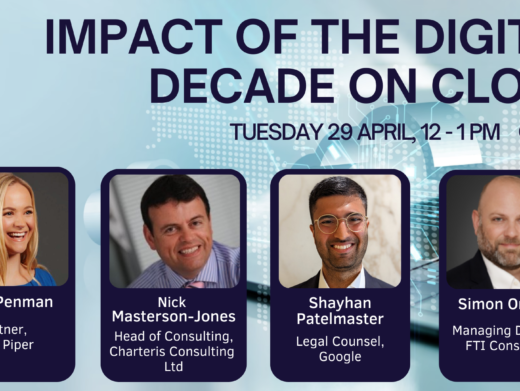Historical events have always influenced the law and legal practice, which by their nature must adapt to societal and technological changes. For this 50th Anniversary edition of the magazine, Maulik Mittal revisits a time when computers were just becoming a fundamental part of everyday life, and how the Y2K Bug (and especially the reaction and response to it) highlighted the intersection between technology and law.
The Y2K Bug
The Y2K Bug may have sparked global anxiety in the mid-90s, but it resulted from a coding practice started much earlier in the 1950s and 1960s. To minimise use of computer memory, which was extremely expensive at the time, programmers expressed the year in two digits instead of four. So, for example, such legacy systems would process “89” as the year “1989”. However, this raised serious concerns as the world prepared to welcome the new millennium in 2000, as computers could interpret “00” as “1900” instead of “2000”.
This was a time of rapidly increasing use of computer systems in all aspects of daily life, including banking, aviation, government services and more. While coders were aware of and raised concerns of this issue from the 1980s, it sparked public interest and government action in the years leading up to 2000. It is not surprising that awareness of the issue coincided with the dot com boom and global digital transformation, as the modern computer became increasingly popular and fundamental. There were widespread fears that the incorrect processing of the date could have massive impacts including severe mortgage miscalculations, power blackouts, and other damage to and interruption of critical infrastructure services.
What is most striking is that this was a point in history when computer programming and everyday life became intertwined. Until this point there was generally limited large-scale use of familiarity of personal computers. But the Y2K Bug led to the education of different cross-sections of the public of technology and computers, and galvanised the recognition of computers as part of life.
Crisis averted? Or sensationalised hoax?
When 2000 arrived, there were no rolling blackouts, financial institutions did not shut down and global supply chains did not collapse as predicted. Instead, relatively “temporary inconveniences” were reported such as deleted text messages, printer outages and a baby in Denmark was reportedly registered as 100 years old.
But the global effort to avert the expected crisis was itself big business. It was estimated that USD 300 billion was spent on Y2K preparedness, with half of this being in the US. Following the months and years of sensationalism and hysteria, the eventual anti-climax meant that fear of Y2K quickly gave way to derision. The Y2K Bug was quickly criticised as a hoax, and government efforts seen as more examples of poor decision making and overspending.
It is difficult to speculate what would have transpired had no efforts been undertaken to prepare for Y2K. Some critics point out that there were other countries and companies that did not carry out large-scale, expensive preparedness programs but were still largely unaffected. However, this does not recognise that in many cases the software patches to update systems were rolled out worldwide, and even countries which expended less cost and effort on preparedness did update their critical systems. One can also imagine that if large companies (especially if they had publicly spent large sums on Y2K preparedness) then suffered internal issues, they may not have been keen to publicise these.
Setting aside the “temporary inconveniences”, there were other isolated incidents which indicate the possible severe consequences had no action been taken at all. And while their efforts were largely unrecognised, this is largely attributable to the coders who updated systems in time, preventing any large-scale issues by updating legacy systems across the globe.
The legal response
US legislation
In the US, the impacts of the Y2K Bug were already the subject of lawsuits. Experts feared this enhanced (and largely unknown) litigious landscape could cost businesses and insurers huge amounts in losses. The law stepped in to try to provide solutions. In 1998, the Year 2000 Information and Readiness Disclosure Act was passed in the US to promote the voluntary sharing information needed to discover, avoid, or fix Y2K problems.
Then in 1999, the US Congress passed the Y2K Act as a temporary but major change in US tort law. The Y2K Act sought to protect companies’ exposure to actions related to the Y2K Bug by shifting responsibility for the mitigation of damages, and placing caps on damages. This is a fascinating case study of a relatively rare example of specific, temporary legislation reshaping tort law to account for a specific event.
No specific legislation was passed in the UK, although a voluntary Y2K pre-action protocol was drafted to deal with the potential surge in Y2K litigation – but this was ultimately not adopted.
Y2K clauses
It is interesting to look at global events through the lens of standard contractual clauses. Most recently the COVID-19 crisis saw various pandemic-related provisions rushed into contracts, and a fearful review of force majeure clauses. Before that there were Brexit provisions, amendments to cater for the LIBOR transition, and Eurozone currency warranties.
Similarly, if you dig up large-scale IT contracts entered into just before 2000, you are likely to find a date compliance or Year 2000 warranty, through which commercial parties in the lead up to Y2K sought to allocate their risk and liability. In broad terms, on a scale from customer-friendly to supplier-friendly, suppliers either warranted that Y2K would not cause issues in their products, or disclaimed any liability for such issues. These warranties were seen as an important mechanism for parties to protect against the risk of systems being supplied which would not accurately process and display date data on either side of the year 2000. Other key provisions were seen around continued support and maintenance for a certain amount of time after 1 January 2000. While these clauses likely gave parties some comfort, ultimately such provisions were not generally litigated and we do not have a sense of how a court may have applied and enforced such provisions.
Wider impacts
Y2K preparedness was a big, expensive exercise that required a massive demand for programmers, engineers and IT professionals. Companies and states, especially the US, needed a big pool of skilled engineers who were well-versed in the legacy systems that needed to be updated. Enter post-independence India which had invested heavily in IT education and building its workforce, and clearly had the population. You can connect the dots directly between Y2K and the rise of the Indian IT BPO industry, as the US and other countries heavily utilised Indian service providers for the work. This jump started the industry, and in turn helped further upskill engineers and led to the growth of the major players that dominate the industry today.
Looking ahead
The effects and learnings from the Y2K Bug are still prescient today, in terms of systems redundancy planning and futureproofing; and the use of warranties and limitations of liability by commercial parties to cater for real-world risks is a practice that will stay relevant. As for Y2K itself, while we can be thankful nothing more dramatic happened in the end (likely at least in part to the efforts taken), clearly the event has a lasting impact on pop culture, history and technology. Looking ahead, as use cases such as crypto mining become increasingly processing-hungry and concerns grow around generative AI, we wait to see whether history holds another Y2K level event.

Maulik Mittal is a senior associate in Baker McKenzie’s Commercial, Tech and Transactions team based in London. His practice focuses on drafting, negotiating and advising on complex, international technology and commercial contracts. He has also completed secondments to Google’s commercial legal team and Three UK’s commercial and networks team.





